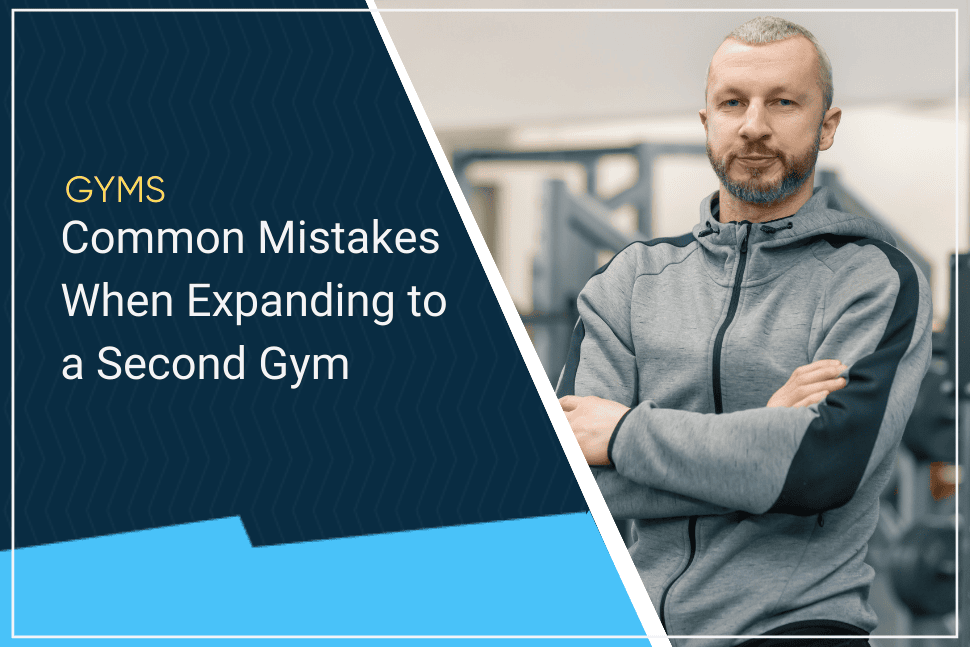Gym Startup Financing Options for You to Consider

The path to launching a gym starts with passion, but it soon ends with the bottom line.
Let's be real:
You are going to need a lot of money to turn your dream into reality. Unless you understand the importance of robust financial planning and securing the right funding, you will struggle to get your business off the ground.
In this article, we’ll provide a comprehensive guide to the somewhat confusing maze of financial options for your gym startup.
Here’s what we’ll cover:
- Self Funding
- Traditional Bank Loans
- Small Business Administration (SBA) Loans
- Investors
- Grants and Competitions
- Alternative Financing Options
- Financial Planning and Management
Self-Funding
Self-funding comes from personal savings, loans, and investments from friends and family. Using your own money gives you complete control over your business. You make all the decisions with no accountability to gym investors or lenders.
If you can self-fund your gym, you’ll avoid taking on debt, so there will be no monthly loan repayments and no accumulating interest. You may also find that your motivation and commitment to the business increase when you invest your money.
However, there are some cons to using your personal savings. If the gym fails, you will lose all your personal savings. Your personal money may also not be enough to set up the gym you envisaged, resulting in a less ideal gym than you would like.
Another option is to top up your personal savings by borrowing money from family and friends. If you decide to follow this route, you must have clear, written agreements outlining the loan amount, applicable interest rate, repayment schedule, and other applicable terms. This keeps everything professional and avoids future misunderstandings.
The repayment plan for the loan should be realistic. If you default on repayments, you are likely to create personal tension and lose trust with your lender. However, you need to make it clear from the outset that there is a possibility that the investor may not get their money back if the business fails.
Family and friends may provide more flexible repayment terms and lower interest rates than banks. You also won’t have to undergo the lengthy and often painful approval process that comes with seeking money from a traditional lender.
You should know that borrowing from family and friends can strain personal relationships. Due to complacency, you may also tend to minimize the importance of repayments.
Traditional Bank Loans
Traditional bank loans provide a structured way to secure your gym funding. You will need collateral to secure the gym business loan. This may be real estate (your house) or other valuable assets. This is known as a secured loan, which usually has a lower rate than an unsecured loan.
An unsecured loan doesn’t require collateral but will have a much higher interest rate to compensate for the higher lender risk. They also have much stricter qualification criteria.
A term loan provides you with a lump sum amount repaid with interest over a fixed term. This type of gym business loan is best for buying equipment or renovating your gym space.
A line of credit gives you access to a set amount you can draw down as needed. Interest is only paid on the amount used. This type of loan is ideal for helping manage cash flow and covering unexpected expenses.
Traditional bank loan approval will require a high credit score that shows that you are a reliable borrower with a sound financial history. You will also have to provide the bank with a detailed business plan and financial projections. The business plan should detail your market analysis, business model, marketing strategy, and management team. Your financial projections should include income statements, cash flow forecasts, and balance sheets. The whole point is to show how you plan to achieve profitability.
Small Business Administration (SBA) Loans
The SBA has a number of loan programs designed for small businesses. They generally offer better terms than traditional banks and offer government-backed guarantees. Let’s explore three types of SBA loans that may be available to you:
7(a) Loan Program
This is the most common SBA loan. Loan terms are quite flexible, and interest rates are very competitive.
504 Loan Program
This SBA loan program is intended for significant fixed assets, like buildings or equipment. You can apply for a 504 loan to buy your gym facilities and start-up equipment.
Microloan Program
This program is intended for start-ups that require $50,000 or less in funding to purchase equipment or inventory.
SBA loans generally require a smaller down payment than traditional bank loans. They also offer longer repayment terms, reducing monthly payments. The SBA guarantees a portion of the loan, reducing the lender’s risk.
To qualify for an SBA loan, you must:
- Be a for-profit business operating in the U.S.
- Meet the SBA’s size standards for small businesses.
- Have a reasonable owner-equity investment.
- Demonstrate a need for the loan.
During the application process, you will need to produce
- Your business plan
- Financial statements
- Credit history
- Collateral
- Legal documents include business licenses, leases, articles of incorporation, and contracts.
The advantages of an SBA loan are the favorable terms, access to large amounts of money, and support and resources provided. However, there are some potential drawbacks. The application process is detailed, requiring a lot of documentation. It can also be challenging to meet their eligibility requirements. You may also have to put up collateral, which may not be possible for some people.
Investors can provide money and expertise to your gym start-up. There are several types of investors, and it’s essential to understand each before approaching them.
Angel Investors
Angel investors fund start-up businesses in exchange for a share of the equity or convertible debt. These people are often experienced business people with a history of investing in start-ups they believe in. In addition to investing money, angel investors may offer mentorship, industry connections, and business advice.
The first step to attracting an angel investor is to develop a strong business plan. In it, you should outline the gym’s vision, market analysis, competitive landscape, and financial projections.
Go to industry events, networking functions, and startup meetups to make contact with potential investors. Build a relationship before pitching for money.
Develop a persuasive pitch highlighting your gym’s unique value proposition, the market opportunity, and why you are best positioned to meet it. Be prepared to address potential concerns the angel investor may have. Highlight any early success or traction you have already achieved. This could include pre-sales, partnerships, and customer testimonials.
Venture Capital (VC) Firms
VC Firms invest in start-ups that they perceive to have high growth potential in exchange for equity in the business. They usually invest more than an angel investor would. They prefer businesses that have already succeeded and are ready to scale. These companies prefer businesses in the tech, health, and fitness sectors.
Start researching VC firms that have previously invested in the fitness industry and that align with your business goals. Next, prepare a pitch deck that should include an overview of the gym’s concept, market opportunity, business model, financial projections, and team. The company will want to show that you have potential for scalability by outlining your growth strategy.
Be prepared to negotiate the terms of the investment, including the amount of equity you will give up, the business valuation, and the role of the VC in your company. To get an idea of what you will be in for, watch a few episodes of Shark Tank.

Equity Crowdfunding
Equity crowdfunding utilizes online platforms to raise capital by selling shares in your company. Here are some popular platforms:
- Kickstarter: While traditionally used for rewards-based crowdfunding, Kickstarter now offers equity options for specific projects.
- Indiegogo: Similar to Kickstarter, Indiegogo provides equity crowdfunding opportunities.
- SeedInvest: Focuses on startups and growth companies, offering equity investments from accredited and non-accredited investors.
- Crowdcube: A UK-based platform that allows investors to invest in early-stage businesses in exchange for equity.
Equity crowdfunding platforms expose your investment opportunity to many ‘mom-and-pop’ investors interested in supporting exciting new ventures. A successful campaign can validate the gym concept and market potential and generate substantial buzz for the business.
Be aware that a crowdfunding campaign requires much time and effort. Giving shares to all of your investors will also dilute your ownership. If you decide to go down this route, ensure that you investigate the regulatory landscape, which can differ significantly from state to state.
Government Grants
Government grants are offered at federal, state, and local levels. Here are some grant opportunities that your gym start-up may qualify for:
Federal Grants: Agencies like the U.S. Department of Health and Human Services, the National Institutes of Health, and the U.S. Department of Agriculture often provide grants that can apply to health and wellness businesses.
State Grants: Each state offers small businesses its own set of grants. Check with your state's economic development agency or small business office to learn about specific opportunities.
Local Grants: Cities and counties sometimes offer grants to encourage local economic development. Contact your local chamber of commerce or economic development office for information on local grant opportunities.
Specialized Grants: Some grants are targeted toward specific groups, such as women-owned businesses, minority-owned businesses, or veteran-owned businesses. Organizations like the Women's Business Enterprise National Council (WBENC) and the Minority Business Development Agency (MBDA) provide resources and support for these groups.
There is a lot of competition for these government grants, so you will have to prepare well. Begin by researching grants that align with your business. Check that you are able to meet all the eligibility criteria. A database of federal grants is available on Grants.gov.
Once you have found the grant you wish to apply for, complete a detailed proposal outlining your business plan. You will also need to detail the specific project or need the grant will meet. Include as much supporting data as you can, along with financial projections.
Follow up with the gran provider after applying. Be ready to answer any questions or provide additional information if required. If you are fortunate enough to receive a grant, you must comply with reporting protocols. You may also have to undergo audits to ensure the funds are properly utilized.
Alternative Financing Options
If you are unable to meet your needs with conventional financing methods, there are a few alternative financing options to consider:
Equipment Financing
Equipping your gym is going to be one of your most significant expenses. Equipment financing can reduce the financial burden by allowing you to equip your facility without an upfront capital outlay. This can be done by leasing the equipment rather than buying it. Most leasing contracts cover equipment maintenance. You can also usually upgrade to new equipment at the end of the lease term. Your lease payments can also be written off as a tax expense.
You may also be able to get a loan specifically for purchasing equipment, with the equipment itself used as collateral. Some manufacturers also offer financing options directly to buyers.
Peer-to-Peer Lending
Peer-to-peer (P2P) lending connects borrowers directly with individual investors through online platforms, providing an alternative to traditional bank loans.
Here’s how the process works:
- Application: Borrowers apply for a loan on a P2P lending platform, providing details about their business and financial situation.
- Approval and Listing: The platform assesses the application, and if approved, the loan request is listed on the platform for investors to review.
- Funding: Individual investors can fund part or all of the loan amount, pooling their money to meet the borrower’s needs.
- Repayment: Borrowers repay the loan over a fixed term with interest, and the platform distributes the payments to the gym investors.
Wrap Up
We've covered a comprehensive range of financing options, from self-funding and traditional bank loans to SBA loans, investors, grants, and alternative financing methods. Each option has its pros and cons, and your choice depends on your unique situation.
As you navigate the maze of gym startup financing, keep your long-term goals in sight. Be thorough in your research, diligent in your planning, and strategic in securing the right funding mix.
Gym management software that frees up your time and helps you grow.
Simplified billing, enrollment, student management, and marketing features that help you grow your gym or martial arts school.





